When YouTube announced Cosmic Panda last year, the redesign was touted as the future of social entertainment—a new way for viewers to engage with content and the logical next step in Google’s attempt to compete with television.
Cosmic Panda changed more than the layout, however. It compromised the very essence of YouTube at the expense of those that helped establish the site: homegrown celebrities like Shane Dawson, Smosh, and MysteryGuitarMan, the latter reporting a staggering 60 percent drop in traffic from the switch.
“Once you took a quick glance around the new design, the writing was on the wall,” wrote Benny and Rafi Fine of the Fine Brothers, the duo responsible for the popular Kids and Teens React series. “[V]iewership was about to drop.”
The heart of the controversy lies in the revision of YouTube’s front page. Instead of showcasing aggregated trending and popular videos—a feature many content creators used strategically to help develop their production schedules—the new layout attempts to offer a more personal experience, based on the channels users are subscribed to.
Divided into multiple vertical streams, the page displays a timeline of content from subscribed-to channels, YouTube-recommended videos, a handful of trending videos, and a menu that takes users to other categories.
Jonathan Paula, a YouTube veteran who reached micro-Internet fame for his Is It A Good Idea To Microwave This? series, called the new homepage “a poor use of space” that “completely de-emphasizes the importance of channel names, view-counts, and most-importantly—the visibility and readability of the thumbnail.”
“Before Cosmic Panda, the YouTube front page was kind of like the daily Holy Grail of YouTube creators, precisely because it wasn’t particularly customized,” added Henry Reich, best known for his channel, Minute Physics, where he gives 60-second science tutorials on a dry-erase board.
“In fact, the frontpage ha[d] the power to make or break your career, because when four of my videos were featured in the ‘spotlight’ section of the front page last October, my channel got 7 million views and 40,000 new subscribers in one day, and now I’m a professional YouTuber.”
That avenue of showcasing new talent no longer exists—at least not in a practical sense.
More alarming than the loss of audience, however, is the financial impact that viewership came with. Top content creators came to count on the extra homepage traffic and, on YouTube, where pageviews directly translate into advertising revenue, the paycheck boost that accompanied it.
“[S]ince we have always been giving most of our profits to charity, it’s more the charities we donate to that suffer under it,” explained Athene Wins (real name Bachir Boumaaza), a Belgian gaming commentator and professional poker player who estimates he lost roughly 70 percent of his traffic.
As Max Lupo noted on Google+, even Ray William Johnson, YouTube’s first user to reach 1 million subscribers, has also been affected by the layout. He’s seen a 30 percent drop in views since December, judging from YouTube analytics site vivdstatsx.com. (A subscriber bug, reported last month by the Daily Dot, appears to have compounded the traffic loss.)
But it’s not just the major content creators that are coming up short—not by a long shot.
“Last year I was averaging 2000 to 4000 views a video,” wrote YouTuber Chris Robinson on Google+. “Since the layout change I’m averaging 300 to 500 views.”
Josh Hamilton, another small-time video creator, wrote on Google+ that he used to get 600-1000 views, but “now I am jumping for joy if we hit 300.
“It is horrible and now there is no chance for smaller channels that are building to get any exposure.”
At least to some degree, the effect is intentional.
The Google-owned company said in an Ad Age article that Cosmic Panda is supposed to highlight engagement and time spent on the site, which is an easier sell for advertisers. YouTube is no longer emphasizing clicks.
“While transitions can be hard, the data directly resulting from these changes is really encouraging: net daily subscriptions are up 50% since January and watch time has been increasing in the past 2 months,” the company wrote.
In a blog post, YouTube called the “impact for some creators” a “short term” issue, adding the new change in business model (of longer engagement) “can be a bit of a shock.” (YouTube declined to comment for this article.)
The real shock, for Reich at least, has been the lack of input by the YouTube community.
Users have been protesting the changes in various capacity since last summer. “We YouTubers have built our content and our careers upon a very particular framework,” Reich said, “and now we know we can’t trust that framework.”
The outcry reached a fever pitch this Monday, led by Onision. The controversial, six-year YouTube veteran has made three videos on the perceived death of YouTube in the last week, posted a detailed blog entry on the matter, and rallied the community on Twitter with the hashtag, #SaveYouTube. (#FixYouTube later trended globally on Twitter.)
“It’s not about money specifically, but viewership and growth,” Onision, whose views have dropped 50 percent since the transition, told the Daily Dot.
“The biggest problem is watching something you’ve been working on for years slowly die.”
